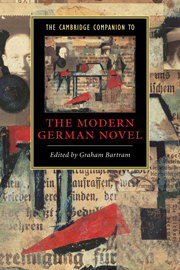Book contents
- Frontmatter
- 1 The German novel in the long twentieth century
- 2 Contexts of the novel
- 3 The novel in Wilhelmine Germany
- 4 Gender anxiety and the shaping of the self in some modernist writers
- 5 Franz Kafka
- 6 Modernism and the Bildungsroman
- 7 Apocalypse and utopia in the Austrian novel of the 1930s
- 8 Images of the city
- 9 Women writers in the ‘Golden’ Twenties
- 10 The First World War and its aftermath in the German novel
- 11 The German novel during the Third Reich
- 12 History, memory, fiction after the Second World War
- 13 Aesthetics and resistance
- 14 The kleiner Mann and modern times
- 15 The ‘critical’ novel in the GDR
- 16 Identity and authenticity in Swiss and Austrian novels of the postwar era
- 17 Subjectivity and women’s writing of the 1970s and early 1980s
- 18 The postmodern German novel
- Index
- Series List
3 - The novel in Wilhelmine Germany
from realism to satire
Published online by Cambridge University Press: 28 May 2006
- Frontmatter
- 1 The German novel in the long twentieth century
- 2 Contexts of the novel
- 3 The novel in Wilhelmine Germany
- 4 Gender anxiety and the shaping of the self in some modernist writers
- 5 Franz Kafka
- 6 Modernism and the Bildungsroman
- 7 Apocalypse and utopia in the Austrian novel of the 1930s
- 8 Images of the city
- 9 Women writers in the ‘Golden’ Twenties
- 10 The First World War and its aftermath in the German novel
- 11 The German novel during the Third Reich
- 12 History, memory, fiction after the Second World War
- 13 Aesthetics and resistance
- 14 The kleiner Mann and modern times
- 15 The ‘critical’ novel in the GDR
- 16 Identity and authenticity in Swiss and Austrian novels of the postwar era
- 17 Subjectivity and women’s writing of the 1970s and early 1980s
- 18 The postmodern German novel
- Index
- Series List
Summary
There are advantages to coming late to an outlook and a set of conventions like realism, and arriving there via a different national tradition. It is sometimes claimed that all the realist writers of note subvert the realism they represent. If this is so, then perhaps those who come last are likely to be more subversive than their predecessors. For at least three of the novels I am taking as paradigms in this chapter the claim has been made that they bring the German novel at long last into the European realist tradition; and also that each of them is in some way the culmination of that tradition.
For at least three of the novels I am taking as paradigms in this chapter the claim has been made that they bring the German novel at long last into the European realist tradition; and also that each of them is in some way the culmination of that tradition. Effi Briest, Buddenbrooks and Der Untertan have all been ranked among major social novels in the European canon of realism; they embrace ‘society’ not as a backcloth to individual human experience (as in the Bildungsroman tradition described in chapter 6 of this book), but as its constituent element. (It is however worth noting that none of them deals with the conditions of lower-class life.)
- Type
- Chapter
- Information
- The Cambridge Companion to the Modern German Novel , pp. 31 - 45Publisher: Cambridge University PressPrint publication year: 2004
- 1
- Cited by

